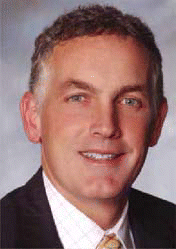Intraoperative CT scanning is a new modality that may allow physicians to assess resected areas and determine if any residual tumor remains, said Dr. Batra. “At an early juncture, we have found this modality to be a helpful adjunct for tumor resection.”
Explore This Issue
November 2007Limitations and Disadvantages
When compared with open skull base surgery, an endoscopic procedure may take longer, noted Dr. Snyderman. “It can be physically and emotionally exhausting to perform the procedure for hours on end,” he said.
In addition, there may be a higher incidence of small postoperative CSF leaks because reconstruction using endoscopy is more difficult than reconstruction with an open procedure, said Dr. Snyderman. “You have a better opportunity for watertight reconstruction with open surgery,” he said.
In the nose, surgeons have to use a multilayer technique that is not watertight, he explained. Consequently, physicians will often use packing to exert pressure on the reconstruction to encourage tissue healing. A nasal septum mucosal flap, however, can cover openings leading to the cerebrospinal region and can improve healing, said Dr. Snyderman.
The level of technical expertise required to perform skull base endoscopic procedures can also be a limitation, said Dr. Batra. “You also have to have the necessary equipment, usually available at a tertiary care center, and a multidisciplinary team,” he said.
Another limitation is this procedure has a shorter track record compared with traditional operations, said Dr. Batra. “All centers are trying to accrue greater experience to make sure endoscopic skull base surgeries are as good as open approaches,” he said.
There are still a lot of missing data on outcomes for various tumor types using endoscopic skull base surgery, agreed Dr. Snyderman, adding that it will be a number of years before data show whether open and endoscopic skull base surgeries are comparable or if one is better than the other. “Early results suggest that the endoscopic procedure is a just as good with less morbidity,” he said.
Team Approach Needed
To help ensure the best outcomes of endoscopic skull base surgery, some institutions have developed a team approach to the procedure, said Dr. Stack. These teams will generally include neurosurgeons and otolaryngologists, as well as rhinologists, medical oncologists, and radiation oncologists, according to the experts interviewed for this article.
Despite the need for a multidisciplinary approach, individual otolaryngologists–head and neck surgeons perform the majority of procedures, said Dr. Stack. Rhinologists also perform sinus surgery and have developed the ability to do more complex procedures over time, he added.

Leave a Reply